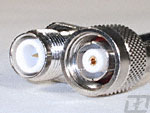Upgrading the Linksys WRT54GS antenna: Difference between revisions
No edit summary |
No edit summary |
||
| (6 intermediate revisions by 2 users not shown) | |||
| Line 1: | Line 1: | ||
The Linksys WRT54GS |
The Linksys WRT54GS comes with two factory-installed omnidirectional external antennas, which are good for indoor usage. They are both located on the router's back and can be easily detached. The free sockets can be used to attach higher gain omnidirectional antennas or directional antennas, in order to extend the acess point's communication range. Usually, only one new antenna is installed and the other socket is left empty, because harmonizing two antennas is rather difficult. The new antenna will be connected to the WRT54GS through a cable, which is called a pigtail. The pigtail has two connectors: One that connects to the WRT54GS, and another that connects to the antenna. |
||
Additional extension cables can be used, but try to keep their length and the number of connectors at a minimum as they all reduce the strength of the received/transmitted radio signal. |
|||
In general: Try to keep antenna cables as short as possible and use as few connecotrs as possible as they all reduce the signal strength. |
|||
[[Image:Wlan_range_rp_tnc_150.jpg|thumb|RP-TNC connector]] |
[[Image:Wlan_range_rp_tnc_150.jpg|thumb|RP-TNC connector]] |
||
Latest revision as of 19:07, 11 March 2005
The Linksys WRT54GS comes with two factory-installed omnidirectional external antennas, which are good for indoor usage. They are both located on the router's back and can be easily detached. The free sockets can be used to attach higher gain omnidirectional antennas or directional antennas, in order to extend the acess point's communication range. Usually, only one new antenna is installed and the other socket is left empty, because harmonizing two antennas is rather difficult. The new antenna will be connected to the WRT54GS through a cable, which is called a pigtail. The pigtail has two connectors: One that connects to the WRT54GS, and another that connects to the antenna. Additional extension cables can be used, but try to keep their length and the number of connectors at a minimum as they all reduce the strength of the received/transmitted radio signal.

Connector WRT54GS -> Antenna Cable
Linksys uses the RP-TNC antena connector for most of its products ('RP' stands for 'Reverse Polarity').